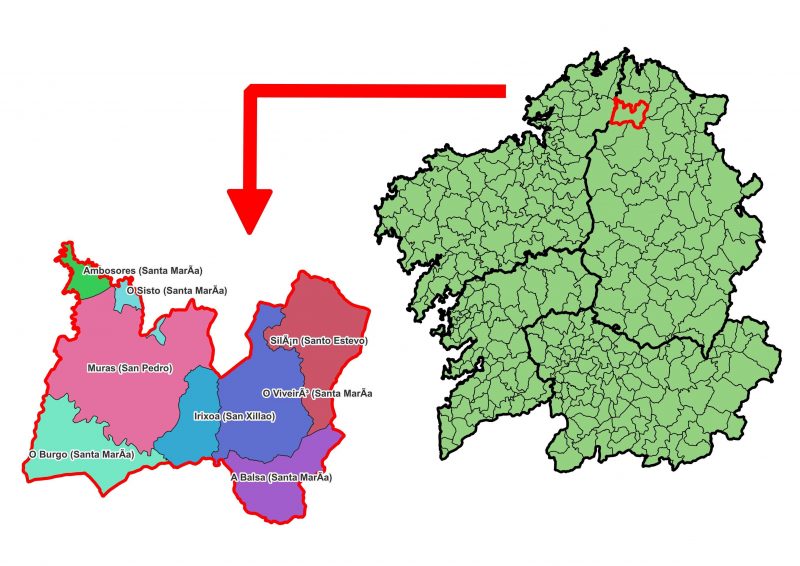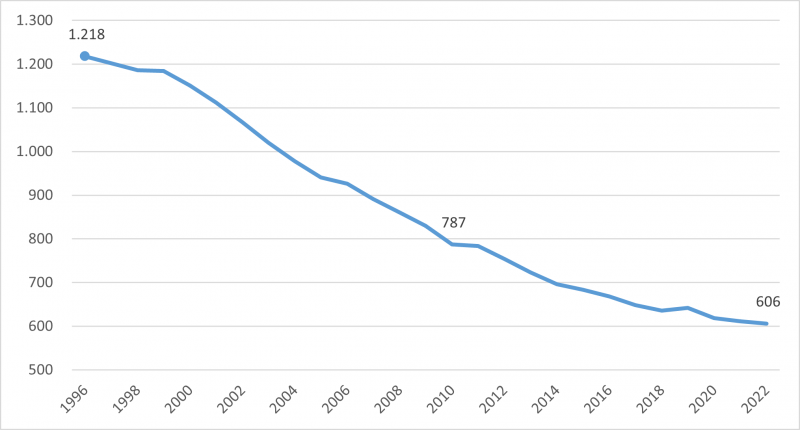
Introduction
The Municipality of Muras is located in the region of Terra Chá, in the north of the province of Lugo and 74 kilometres from the provincial capital. It is a territory close to the coast, with 600 inhabitants in 2022, which has an area of 164 square kilometres, presenting a degree of urbanisation of sparsely populated area, according to the Galician Institute of Statistics.
It is part of the Terra Chá Rural Development Group (RDG2).

Population and demographic structure
The population of Muras showed a steady loss of inhabitants during the period between 1991 and 2022. This decline resulted in a loss of 830 inhabitants, or 58%. This reduction significantly exceeded the fall rates of 1.5% observed in Galicia and 15.7% registered in the province of Lugo during the same period.
In the decade from 2012 to 2022, a less pronounced demographic decline was observed in Muras, with -20%, and Lugo, with -7%, but more pronounced in Galicia, with -3.3%. This phenomenon highlighted the persistent trend towards population loss and territorial demographic imbalance, particularly evident in rural areas.
In Muras, this demographic decline was accompanied by changes in the age distribution, leading to a progressive ageing of its population. Between 2002 and 2022, the age group most affected by this population reduction was that of young people under 16 years of age, which experienced a reduction of 52%, equivalent to 40 fewer people. In addition, both the working-age population aged 16 to 64 and the population aged 64 and over experienced reductions of 46% and 37% respectively. The over-64 age group registered a larger decrease of 21%, while the under-64 age groups showed a slowdown with a loss of 15% of the young population and 19% of the adult population.
Muras has an ageing demographic which is reflected in the reduction of the base and the increase of the top of the population pyramid, as well as the increase of the average age. The average age of the inhabitants in the year 2022 was close to 56 years, being the same for both genders.
The Total Dependency Ratio (TDR) in Muras reached its highest point in 2019, registering 94%, after a continuous increase since 1998, and notably different from the Galician and provincial level (65%). However, from that year onwards, Muras showed a decreasing trend until 2022. This decrease was attributed to the deceleration of the working age population rate, in contrast to the dependent population. Thus, in 2022 it stood at 84%, slightly less than twenty percentage points above the Galician and provincial rates. This evolution suggests a relatively favourable demographic dynamic in Muras in recent years, in contrast to the trend experienced until then.

Population dynamics in Muras.

Evolution of the total dependency ratio of Muras, Lugo and Galicia.
Economy
The evolution of Gross Disposable Product (GDP) followed a growth dynamic that contrasts in some periods with that observed in Galicia as a whole and in the province of Lugo. During the 2010s, the municipality’s GDP growth rates were predominantly positive, except in the period between 2014 and 2016, when there was a significant reduction of 22.7%. However, between 2018 and 2020, as a consequence of the effects of the pandemic, GDP contracted at all three territorial levels, registering a decline of 9% in Muras, in line with the reductions observed in Galicia, with -7.7%, and Lugo, with -7.2%. In 2022, the municipal GDP was close to 57.7 million euros.
The Gross Disposable Income (GDI) showed a remarkable growth between 2002 and 2020, especially between 2002 and 2005, with 20.6%, exceeding the figure of 14,000 euros. Subsequently, it showed a downward trend until reaching 12,270 euros in 2020, with a slight stagnation due to the pandemic, which resulted in a slight fall of 0.3%, compared to decreases of 3% and 1.8% in Galicia and Lugo respectively. In global terms, it showed an increase of 4.55% in the period analysed (2002-2020), similar to that of Galicia (9.8%) and the province of Lugo (9%).
Using the register of social security affiliations as an estimate of municipal employment, between 2011 and 2022, Muras showed a fall in the number of affiliations. During the period 2011 to 2022 there was a reduction of 17.8% in the total number of affiliations, while at the regional level there was an increase of 8%, remaining stable at the provincial level. Analysing by sector, the primary sector decreased by 25.6%. The secondary sector recorded a loss of 14%. Both sectors represented 57% of the total number of affiliates. The tertiary sector lost weight with a reduction in the number of affiliates of 13% and represents 42.6%.
In 2022, Muras had an activity rate of 72.4%, with a notable difference of twenty percentage points compared to the average for Galicia and Lugo. The employment rate also experienced an increase, standing at around 66%. The unemployment rate shows a gradual decrease from 13% in 2014 to 8.5% in 2022.

Evolution of Gross Disposable Income per inhabitant in Muras, Lugo and Galicia.

Evolution of employment, unemployment, and activity rates in the municipality of Muras.
Energy resources
Muras has an endowment of energy from renewable sources, specifically wind power. With a total of 380 wind turbines and an installed capacity of 264.42 MW, Muras achieves an estimated annual production of between 545,942.5 and 767,845 MW per year. However, diversification of renewable energy sources is essential to strengthen the energy resilience of the municipality and maximise its economic potential. The expansion of other forms of renewable energy, such as solar, hydro or biomass, would not only help to reduce dependence on a single source, but could also generate new economic and employment opportunities in the area.
The electricity consumption of Muras in 2023 was estimated at 9,953.29 MWh. Residential consumption was 733.60 MWh. Utility consumption, including municipal services, was 310.09 MWh. Industry consumed 8,909.60 MWh.
Energy Policy Councils
Date of the first meeting:
30th April 2024
Profile of participants:
- Staff of the municipality of Muras: municipal government
- EC4RURAL project staff: UVIGO
Evaluation of the energy situation
The municipality of Muras is unique in Galicia for several reasons. It is located in the Terra Chá region of Lugo, part of the Serra do Xistral, a Site of Community Importance (SCI), where the most important ombrotrophic bogs in Europe can be found. Its territory is home to nearly 400 wind turbines with a total capacity of 264 MW. Since 2016, the municipal government has launched a programme to support local electricity consumption, providing each household and business with an annual amount that offsets a very high percentage of the annual electricity consumption of each of these actors. In addition to these differential elements, Muras, like many rural municipalities, suffers from a constant loss of population and low density.
Dialogue between the parties
In this context, the project technicians met with the local government. As a result of this meeting, where the objectives of the project and the local specificities were shared, it was decided to look for an energy community model that would respond to the specific challenges of this small municipality in the province of Lugo.
Conclusions
The main objective is to take into account the dispersion of the population and to include a strategy to gradually replace the municipal support programme for electricity consumption with a community initiative for the production of electricity from renewable sources.


